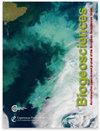温带地区沿海咸水湿地甲烷和二氧化碳排放的驱动因素和限制因素
IF 3.9
2区 地球科学
Q1 ECOLOGY
引用次数: 0
摘要
摘要沿海湿地能够在土壤中储存大量有机碳,因此在减缓气候变化方面发挥着重要作用。然而,众所周知,退化的淡水湿地也是甲烷(CH4)的第一天然排放源。众所周知,盐度会抑制 CH4 的产生,但人们对盐度在咸水生态系统中的影响还知之甚少。本研究有助于了解环境变量如何影响沿海温带湿地的温室气体(GHG)排放。我们介绍了在意大利拉文纳附近亚得里亚海东北部沿盐度梯度的四个湿地中进行的一年多测量结果。通过对土壤取样取芯确定了土壤特性,同时使用便携式气体流量计每月监测土壤和积水中的二氧化碳(CO2)和甲烷(CH4)流量。此外,每月还通过多参数探头监测水位以及地表水和地下水的物理化学参数(温度、pH 值、电导率和水中的硫酸盐浓度)。我们观察到,当水深超过 50 厘米的临界值时,CH4 排放量大幅减少。无论水的盐度值如何,淡水系统的平均甲烷通量为 5.04 gm-2d-1,咸水系统的平均甲烷通量为 12.27 gm-2d-1。相反,当水深浅于 50 厘米时,淡水系统中的甲烷通量平均为 196.98 克/克-2d-1,而咸水/海水中的甲烷通量结果不显著。二氧化碳通量的结果显示了与甲烷通量相同的行为,尽管在统计上并不显著。温度和辐照度对水和土壤中的甲烷排放量影响很大,导致夏季和春季的甲烷排放量较高。本文章由计算机程序翻译,如有差异,请以英文原文为准。
Driving and limiting factors of CH4 and CO2 emissions from coastal brackish-water wetlands in temperate regions
Abstract. Coastal wetlands play a fundamental role in mitigating climate change thanks to their ability to store large amounts of organic carbon in the soil. However, degraded freshwater wetlands are also known to be the first natural emitter of methane (CH4). Salinity is known to inhibit CH4 production, but its effect in brackish ecosystems is still poorly understood. This study provides a contribution to understanding how environmental variables may affect greenhouse gas (GHG) emissions in coastal temperate wetlands. We present the results of over 1 year of measurements performed in four wetlands located along a salinity gradient on the northeast Adriatic coast near Ravenna, Italy. Soil properties were determined by coring soil samples, while carbon dioxide (CO2) and CH4 fluxes from soils and standing waters were monitored monthly by a portable gas flux meter. Additionally, water levels and surface and groundwater physical–chemical parameters (temperature, pH, electrical conductivity, and sulfate concentrations of water) were monitored monthly by multiparametric probes. We observed a substantial reduction in CH4 emissions when water depth exceeded the critical threshold of 50 cm. Regardless of the water salinity value, the mean CH4 flux was 5.04 gm-2d-1 in freshwater systems and 12.27 gm-2d-1 in brackish ones. In contrast, when water depth was shallower than 50 cm, CH4 fluxes reached an average of 196.98 gm-2d-1 in freshwater systems, while non-significant results are available for brackish/saline waters. Results obtained for CO2 fluxes showed the same behavior described for CH4 fluxes, even though they were statistically non-significant. Temperature and irradiance strongly influenced CH4 emissions from water and soil, resulting in higher rates during summer and spring.
求助全文
通过发布文献求助,成功后即可免费获取论文全文。
去求助
来源期刊

Biogeosciences
环境科学-地球科学综合
CiteScore
8.60
自引率
8.20%
发文量
258
审稿时长
4.2 months
期刊介绍:
Biogeosciences (BG) is an international scientific journal dedicated to the publication and discussion of research articles, short communications and review papers on all aspects of the interactions between the biological, chemical and physical processes in terrestrial or extraterrestrial life with the geosphere, hydrosphere and atmosphere. The objective of the journal is to cut across the boundaries of established sciences and achieve an interdisciplinary view of these interactions. Experimental, conceptual and modelling approaches are welcome.
 求助内容:
求助内容: 应助结果提醒方式:
应助结果提醒方式:


